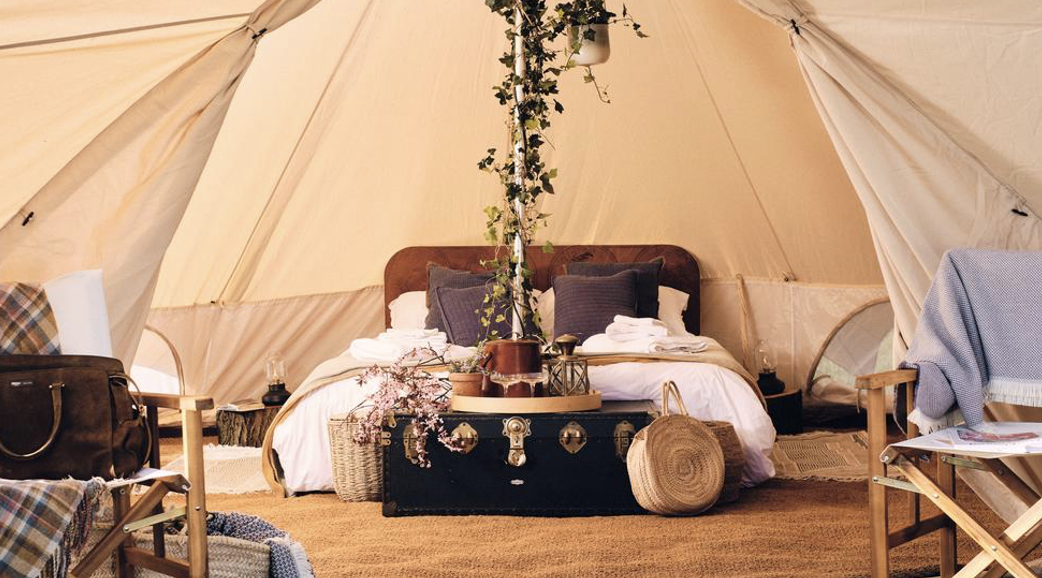Spotlight on Glamping Structures - Safari Tents
THE SAFARI TENT IS ONE OF THE MOST RECOGNIZABLE GLAMPING STRUCTURES. THIS ARTICLE WILL SHED LIGHT ON THE HISTORY AND VERSATILITY OF THIS GLAMPING ACCOMMODATION, AND SHOWCASE SOME POPULAR GLAMPTUARY DESTINATIONS THAT OFFER BEAUTIFULLY ADORNED SAFARI TENTS
Location - Terra dos Anjos
Location - Flat Dogs Camp
When I hear or say the word “safari” – I imagine myself dressed in a full khaki outfit observing lions and giraffes through a large set of binoculars while perched in a small tree. The tent I imagine we’d return to after a day on the plains of Africa would naturally be our “Safari Tent,” so I suppose my imagination isn’t too far-fetched. An African Safari is definitely on my bucket list and I will insist on a safari tent during said Safari. The rest I’ll leave to a trusted guide.
In the glamping world, safari tents are among the most common glamping structures used around the globe. They are fairly easy to set up, durable enough for all 4 seasons, spacious enough for multiple people with gear, and not expensive to purchase compared to many other types of glamping structures. Prices can vary for sure based on the size of the tents and materials used, but generally speaking…safari tents offer a lot of bang for the buck.
The name “Safari Tent” name evolved over the years from the bland-er original name of “Wall Tent.” It was called a wall tent because…well…it had 4 walls. The Wall Tent has also been called a “Sheep Herder” and an “Outfitter Tent.”
Wall Tent - Source - Wikipedia
It’s believed that wall tents date back to the 16th century in the U.K. and were heavily used in the U.S. Civil War.
Source - The Civil War Monitor
Mobility and durability are what made this type of tent popular over the years and not much has changed – which is why it’s still popular today.
If high-grade materials are used and moderate care is applied, safari tents can easily withstand all 4 seasons, last for years, and won’t break the bank to get started. This is what makes this type of glamping accommodation so popular – low cost, efficient and durable. The low cost of start-up means lower costs for glampers as well which is a win-win.
Generally speaking, safari tents are comprised mainly of a heavy waterproof fabric (often cotton, polycotton or nylon based canvas), metal and/or wood for the frame, and rope for support and stability.
There are definitely some more unique options out there for the exteriors of safari tents. For example, “Berber Tents” are a type of safari tent made out of sewn together camel and goat hair. This type of tent is popular in many desert camps like Erg Chigaga Luxury Desert Camp in Morroco.
Location - Erg Chigaga Luxury Desert Camp
Another popular material is bamboo for both the framing AND for the Canvas. One of the leading providers globally of bamboo tents is Mocadazu. They have a HUGE selection of designs and have provided safari tents for numerous eco resorts and glamping operations around the world.
“Mini” safari tent - Design by Mocadazu
Options are varied as far as what’s used for the exterior of safari tents.
The drastic differences are found on the inside. You could say this is where the magic happens…or can happen if the furniture and adornments are styled in a stylish, comfortable and memorable way.
Below are some locations and pics of interiors I’d like to see when I open up my next safari tent on a Glamptuary adventure.
Location - Old Trails Estates near Austin, TX – Talula Mesa Tents
Location - Sonoma, CA - Safari West Wildlife Preserve & African Tent Camp
Location - Mara Region Tanzania - Singita Mara River Camp
Location - Canterbury, UK - Camp Quaives
These options definitely hit the “Glam” note in glamping. Obviously the price usually goes up as the level of glam increases AND I should note – glamping doesn’t need to look and feel like you are royalty. But it’s fun to live the fantasy every once in awhile.
Whether you’re rolling large or working with the basics on the inside – the safari tent will more than suffice as a comfortable glamping structure.
Safe travels Everyone!










